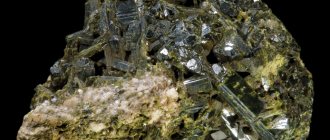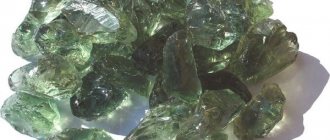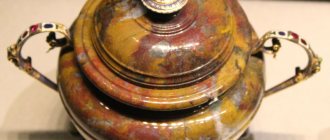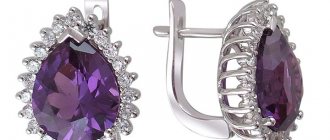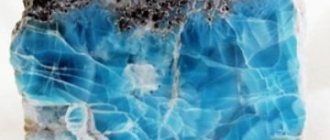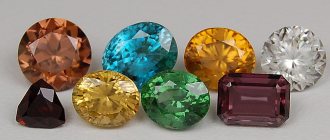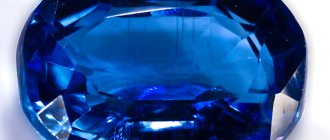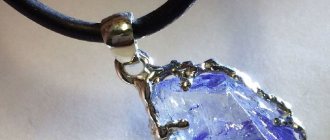Story
The first deposits of the mineral were discovered in the European Alps. Blue anhydrites were given to people by Tyrol, the Austrian section of this mountain system. In 1987, the stone was found in South America: pale blue Peruvian samples were “accompanied” by other minerals.
However, the dissonant term “anhydrite” was considered unsuitable in a commercial sense. The idea for the new name was suggested to marketers by the color description of the stone: heavenly blue, shrouded in haze. This is how the name “angelite” appeared, which became a global trade brand.
The limited production of blue stones led to the fact that all anhydrites began to be called angelites: gray, purple, whitish, milky, reddish.
What is angelite
Anhydrite (angelite) is a modification of anhydrous calcium sulfate. The origin of the stone is sedimentary, it is the result of dehydration of gypsum rocks.
| English name | Angelite |
| Other names (synonyms) | Angel Stone |
| origin of name | Angelite gets its name from the Greek word “aggelos” - angel. |
| singonia | Rhombic |
| Composition (formula) | CaSO4 |
| Color | Blue, bluish-gray, lilac |
| Stroke color | White |
| Transparency | Transparent |
| Cleavage | Perfect |
| Kink | Stepped |
| Shine | Bold, pearlescent, glassy |
| Hardness | 3-3,5 |
| Density (specific gravity), g/cm3 | 2,98 |
| Special properties: | On contact with water it turns into gypsum. |
Angelite is classified according to the color created by impurities in the stone. Each position includes a range of shades from delicate light to rich.
basic information
Angelite stone is actually a calcium-based mineral. As a rule, it occurs in nature in the form of fine-grained masses. But crystals are formed very rarely. The mineral is usually presented in blue, but pink, red, white and gray specimens are also found. The surface is usually transparent or translucent with a glassy sheen. Less common are specimens with a mother-of-pearl tint.
Angelite is characterized by strong fragility. On the Morse scale, its hardness does not exceed 3.5. It is easy to process and also easily damaged. Therefore, it is rarely used in jewelry. More often, simple figurines or panels are made from angelite. The crystal has strong absorbent properties, which is why under prolonged exposure to water it turns into gypsum. And even from prolonged contact with the skin, the mineral deteriorates. By the way, the latter fact makes it possible to use angelite in construction and paper production. Stones that are not distinguished by their beauty and color saturation are allowed into industrial processing.
Where and how is the stone used?
There are several areas of use for angelite. They are determined by the quality of raw materials and the properties of the stone.
Jewelry
According to the jewelry classification, angelite is considered an ornamental stone:
- The frame is democratic: silver, cupronickel, nickel silver, brass.
- In jewelry, angelite is complemented by gems of comparable jewelry value. The combination with rauchtopaz, quartz, serpentine, jasper, and corals is popular.
- Angelite is fragile, so the range of products is limited: pendants, pendants, beads, brooch inserts, earrings.
- For accessories that experience mechanical stress (rings, cufflinks, etc.), the angel stone is practically not used.
Bracelet with angelite
Large companies are not interested in angelite because of its cheapness. Stone work is done by single craftsmen. But almost every hand-made product is unique.
Decor
The main area of application of the stone. Ease of processing, beauty, and decorativeness of the surface have made angelite one of the favorites among stone carvers.
They create small plastic objects, pyramids, eggs, boxes, tableware.
Figures of angels and protective amulets made of angelite are especially in demand.
Collecting
Unusual samples of angelite are valued by collectors of mineralogical collections. Most often these are intergrowths of blue or reddish anhydrite with gypsum, calcite, dolomite, and halite. This is natural, since anhydrite is almost always found in deposits of these rocks.
Other areas
Solid stones of ordinary characteristics become the source material for interior cladding.
Crumbs and other substandard materials are taken by producers of cement, sulfuric acid, and other sulfur compounds.
Scope of application
The stone is common in the manufacture of decorative items for interior decoration. They are also complemented with jewelry. This is the best decoration for:
- candlesticks;
- figurines;
- caskets;
- figurines of angels;
- amulets and other magical instruments.
The mineral is also valuable in the construction industry, where its crumbs are mixed with cement or used as an additive for exterior finishing work.
View this post on Instagram
Posted by Jewelry of natural stones (@olgakamni) Mar 15, 2020 at 2:06 am PDT
Angelite cost
The cost of products with or from angelite on Runet sites is relatively affordable (product/price, rub.):
- earrings (silver) – 3,200;
- bead (4–14 mm) – 25–105;
- pendant (50 mm, silver, leather cord) – 1,500;
- ball (65 mm) – 6,100;
- stone from Peru (67x48x39 mm, 200 g) – 2,500.
This is an assortment offered by craftsmen in a single copy or in limited quantities. Almost all raw materials are from the subpolar Urals.
Application of angelite
In Russia, the popularity of the angel stone is only gaining momentum. It is most common in the USA and other countries of the American continent.
The stone is easy to cut, but at the same time it is quite fragile and vulnerable to moisture, and also deteriorates from interaction with the skin. Therefore, jewelry made from it is beautiful, but short-lived.
Angelite is used to make carved sculptures, boxes, decorative elements, and used in mosaic panels.
All kinds of magical attributes made from angel stone are popular: balls, pyramids, amulets.
Beautiful translucent crystals and druses of angelite are of interest to collectors.
Stones with low decorative characteristics are used in the construction and paper industries.
Stone care rules
You need to care for angelite, taking into account its properties (hydrophobia, Mohs hardness below average, fragility):
- Rule number one is to protect the gem from moisture. Jewelry with angelite should not be worn to the pool, to the beach, or in rainy weather. Angelite is not even worn on a naked body: human sweat will destroy the pebble.
Angel stone, which has absorbed excess moisture, becomes ordinary plaster.
- For storage, select a separate, tightly closed box or casket. This way, the angelite will not be scratched by other jewelry, and water will not get on it.
- Products with angelites are contraindicated from interacting with abrasives. Cleaning the stone with strong household chemicals is also prohibited.
- Mechanical loads can destroy angelite.
- Angelite cannot be cleaned with water. To prevent dirt from accumulating, after each use, wipe it with a slightly damp cloth and immediately wipe it dry.
Moisture, penetrating into the stone, increases its volume and changes its structure. As a result, angelite becomes cracked gypsum.
Therapeutic effect
The healing properties of angelite are manifested in the prevention of:
- The stone strengthens the immune system and puts the human energy cocoon in order.
- Puts a barrier to infections and other ailments.
- Angelite is an indicator of the owner’s health status: when symptoms of illness appear in the corresponding area of the body, severe pain occurs.
- Accelerates the body's recovery after serious illnesses.
Only a natural solid pebble is suitable as a healing or magical talisman.
Medicinal properties
Angelite has the following medicinal properties:
- The “Stone of Angels” is considered a talisman not only against failure, but also against illness. Its main task is to keep infection away from its owner.
- In case of an existing disease, “angel stone” increases immunity, restores the body, gives energy, promotes a speedy recovery and prevents complications.
- The mineral is also endowed with the ability to inform its owner about the disease in advance, provoking a painful attack in the affected organ.
- There is an opinion that it can help stabilize the condition of a mentally ill person and even cure the disease.
Also read: Jarosite - a natural pigment
Magical properties of angelite
Opinions differ about the magical properties of angelite.
Pendant with angelite
Angel Stone
Magicians say: angelite is a “bridge” between a person and his guardian angel . To establish contact with the heavenly patron, the owner of the stone needs to read a spell or ask an angel to fulfill a wish.
Angelite remembers and transmits only one wish. For the next one you need a new pebble.
However, priests (especially Christian ones) deny such influence. After all, this is just blue anhydrite, which became an “angelite” at the behest of marketers. To establish a connection between a stone and the mountain world, the efforts and spiritual work of several generations of owners are needed.
Esotericists of the Western world recommend constantly wearing the gem on your body and exposing it to the rays of the Sun, the light of the Moon and the stars for recharging. This way the angelite will quickly get used to people and the world of light.
Other options
Magicians have identified more mundane, but useful properties of angelite:
- A balance is created between the aura and the physical body.
- The blue-blue tonality of angelite calms emotions and the nervous system as a whole. A person enjoys life, ignoring the negativity that is not worth attention.
- Angelite is indicated for shy people. It helps to express yourself in creativity, business or communication. A person expresses his personal opinion directly and achieves his goals more persistently.
- Angelite magic has a beneficial effect on the throat chakra. This property is used by parents of hyperactive or capricious children. The talisman is placed above the crib or in a body pendant.
- The mineral is indispensable for those suffering from the loss of a loved one.
- Angelite will help overly self-critical individuals start life on a new page, letting go of the past (especially with mistakes).
- Angelite will inspire callous people with a sense of compassion and encourage them to forgive their neighbors. Aggressive ones will become softer.
- Angelite will show you the way to solving problematic issues and getting out of hopeless situations. It makes it easier to start a new project.
Angelite sharpens awareness, which is why it is chosen by lovers of astral travel.
They say that the stone establishes a connection with primordial knowledge, the wisdom of the Universe. The magical properties of angelite make communication at a distance possible.
Restrictions
Angelite is considered the embodiment of the forces of light, goodness, and other good qualities. Therefore, the owner of the stone must be an extremely positive person. Even thoughts with a minus sign are prohibited, otherwise punishment from higher powers will follow immediately and be severe.
If a person is not ready to be a model, it is better not to mess with an angelite.
Healing properties
The breed became famous for its ability:
- strengthen the body's defenses;
- speed up the recovery process after a serious illness or surgery;
- destroy germs (a natural antiseptic that can be used as an alternative to pharmaceutical ones);
- increase stress resistance;
- fight symptoms of anxiety and panic.
The stone is also used to diagnose various ailments: the inflamed organ reacts to the energy of the gem with a pain syndrome, which gives a person a chance to promptly detect one or another health-related problem.
Angelite and Zodiac
The light, delicate energy of the stone has a beneficial effect on the signs of the Zodiac, regardless of the element.
Table of compatibility of angelite with zodiac signs (“+++” – fits perfectly, “+” – can be worn, “-” – is strictly contraindicated).
| Zodiac sign | Compatibility |
| Aries | + |
| Taurus | + |
| Twins | + |
| Cancer | + |
| a lion | + |
| Virgo | +++ |
| Scales | + |
| Scorpion | + |
| Sagittarius | + |
| Capricorn | + |
| Aquarius | + |
| Fish | +++ |
Angelite is especially suitable for Pisces and Virgos.
How to spot a fake
Angelite is most often replaced with plastic. You can distinguish a natural gem from a fake by several signs:
- External characteristics. Natural anhydrite is rough, interspersed with other rocks. Glassy veins are common. Almost always the surface has small cracks or chips.
An absolutely smooth surface of angelite plus uniformity of color or pattern means a fake.
- Hold the sample in your hands. The plastic will heat up immediately, the natural mineral will heat up gradually.
- Assess massiveness: real anhydrite is heavier than plastic.
The authenticity of angelite is of particular importance if it is chosen as a talisman or amulet.
It is better to buy the stone in shops or salons that sell esoteric paraphernalia. A quality certificate is attached to it.
